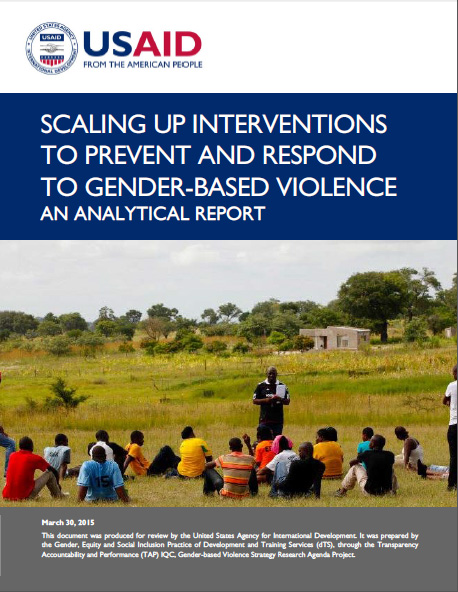Scaling up refers to “taking successful projects, programs, or policies and expanding, adapting, and sustaining them in different ways over time for greater development impact.”[1] While scaling up is a common goal of international development donors and implementers alike, there is no universally accepted methodology that is employed. The three scale-up methodologies explored in this report are: expansion of scope, replication, and expansion of geographic coverage. The objective of this report is to assist USAID staff in identifying and selecting scalable GBV interventions across four sectors: (1) health, (2) youth and education, (3) democracy and governance, and (4) economic growth.
It is a product of a three-pronged research methodology: (1) a literature review, (2) key informant interviews and focus group discussions conducted in Washington, D.C. and by telephone, and (3) data collected from site visits on scaled-up GBV interventions in India and South Africa. Eighteen scaled-up GBV interventions were analyzed in the literature review, eight interventions, which varied by sector and type of scale-up were chosen for further in-depth analysis during the site visits. The mixed-method research design was used to develop this analytical report in order to better understand scaled-up activities to address gender-based violence.
The following best practice examples were selected to illustrate initiatives that provide evidence of success in contributing to the prevention of GBV:
- Health: One Man Can Campaign, Soul City, and Stepping Stones in South Africa
- Youth and Education: Yaari Dosti and Gender Equality Movement in Schools in India
- Democracy and Governance: South Africa’s Thuthuleza Care Centers (TCCs) and the International Justice Mission (IJM) in India
- Economic Growth: The Intervention with Microfinance for AIDS and Gender Equity (IMAGE) in South Africa.
The interventions were selected based on an extensive literature review and interviews with key stakeholders. Based on findings from the site research and the literature review, the research team extrapolated six key lessons learned for designing scalable GBV interventions:
- Align GBV interventions with government commitments to end GBV;
- Secure community ownership for the GBV intervention;
- Provide proof of concept for the GBV intervention;
- Build a GBV prevention and response community of practice;
- Integrate GBV prevention and response into government structures and sectoral programs; and
- Design the GBV interventions with scale in mind.
The report concludes with a checklist tool to help USAID staff design GBV interventions for scale and to assess the scalability of GBV interventions.
[1]. Brookings Institute “Scaling Up: A Path to Effective Development” (2007)








Comment
Make a general inquiry or suggest an improvement.